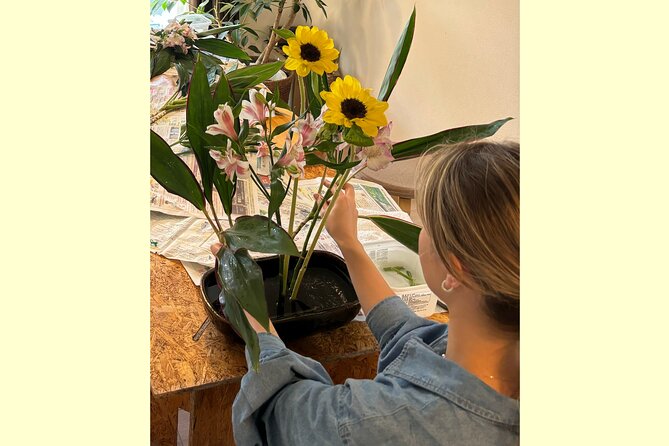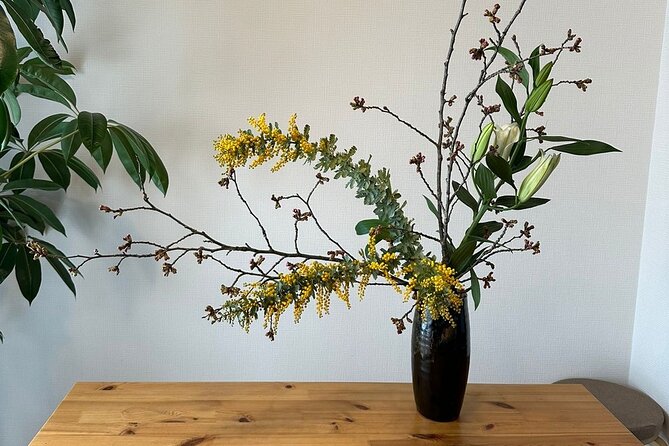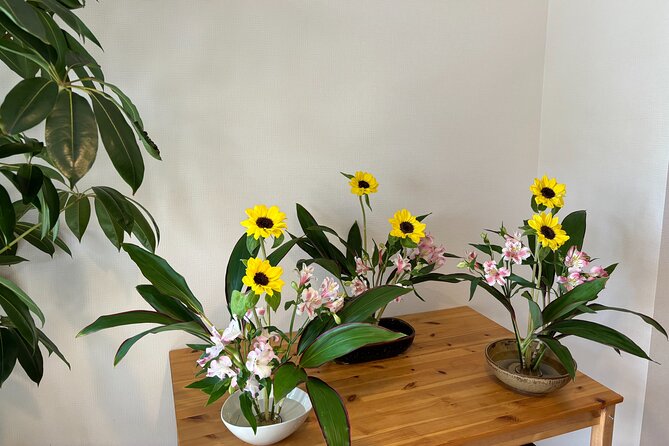Ikebana, the traditional Japanese art of flower arranging, offers a captivating blend of nature, philosophy, and artistic expression. Rooted in Zen Buddhism, this holistic discipline encourages a mindful appreciation for the ephemeral beauty of flowers. Through specific styles like Nageire and Moribana, practitioners cultivate patience and creativity, transforming simple natural elements into breathtaking displays. But the true essence of Ikebana lies in its ability to foster a deeper understanding of the interconnectedness of life. It’s a practice that transcends mere decoration, inviting one to…
Key Points

- Ikebana is the traditional Japanese art of flower arranging that emphasizes the harmonious arrangement of natural elements.
- Ikebana is rooted in Zen Buddhism, with careful selection and placement of flowers, branches, and other natural materials.
- Ikebana follows specific rules and techniques, such as Nageire and Moribana, which cultivate patience, mindfulness, and appreciation for ephemeral beauty.
- The Ikebana experience in Kyoto provides a hands-on and immersive cultural journey, teaching both the practical and philosophical aspects of the art form.
- The Ikebana class is an intimate experience with a maximum of 6 participants, ensuring personalized attention from the instructor and a balance between instruction and creative freedom.
Overview of Ikebana

Ikebana, the traditional Japanese art of flower arranging, is a captivating practice that transcends mere aesthetics.
It’s not just about creating beautiful displays; it’s a holistic discipline that harmonizes nature, philosophy, and artistic expression.
Rooted in Zen Buddhism, Ikebana emphasizes the careful selection and placement of blooms, foliage, and branches to convey a deeper meaning.
Rather than random assembly, Ikebana follows specific rules and techniques, like Nageire and Moribana, that imbue each arrangement with symbolic significance.
Through this meditative process, practitioners cultivate patience, mindfulness, and a profound appreciation for the ephemeral beauty of the natural world.
You can also read our reviews of more tours and experiences in Kyoto.
Location and Accessibility

The Ikebana experience takes place in Kyoto, the historic heart of Japan. The meeting point is located in central Kyoto, easily accessible via public transportation.
While the exact meeting location may change, the host will provide updates prior to the session. The activity itself isn’t wheelchair accessible, but it’s convenient for those able to get around.
After the hands-on flower arranging, participants return to the starting point. With its serene setting and practical logistics, this Ikebana workshop offers an immersive cultural experience in the beautiful city of Kyoto.
Pricing and Inclusions

The Ikebana experience is priced at $60.02 per person. For this cost, you will learn two distinct Ikebana styles: Nageire and Moribana.
The class emphasizes hands-on interaction with flowers and practical application of Ikebana techniques. With a maximum of 6 travelers, the intimate setting allows for personalized attention from the knowledgeable instructor, Mana.
Bookings come with free cancellation up to 24 hours prior, providing flexibility. While the class doesn’t offer wheelchair accessibility, it’s conveniently located near public transportation in Kyoto, Japan.
The pricing reflects the culture and educational value of this traditional Japanese art form.
Participant Capacity and Languages
A maximum of 6 travelers can participate in the Ikebana experience.
The intimate class size allows for personalized attention from the instructor. Both English and Japanese are offered, catering to a wide range of participants.
This accessibility enables travelers from diverse backgrounds to enjoy the traditional Japanese art of flower arranging.
Whether you’re a beginner or have some experience, the Ikebana class provides an opportunity to learn the nuances of this time-honored practice in the serene setting of Kyoto.
Booking and Cancellation Policy
When participants book the Ikebana experience, they receive confirmation of their reservation.
The activity offers free cancellation up to 24 hours before the start, providing flexibility for travelers. This allows them to easily adjust their plans if needed.
The experience has a maximum capacity of 6 participants, ensuring an intimate and personalized learning environment.
The booking and cancellation policy caters to the needs of modern travelers, making the Ikebana class a convenient and hassle-free addition to their Kyoto itinerary.
The policies provide:
- Confirmation of booking upon reservation
- Free cancellation up to 24 hours prior
- Maximum of 6 participants per class
- Flexibility to accommodate changing plans
Instructional Approach and Techniques
Though the Ikebana class emphasizes a hands-on experience with flowers, the instructor, Mana, ensures a balanced approach between practical application and philosophical insights.
Participants learn two distinct Ikebana styles – Nageire and Moribana – and are guided through clear demonstrations.
Beyond the technical aspects, Mana imparts the deeper meaning and history of this centuries-old art form.
Reviews praise her ability to strike the right equilibrium, allowing ample creative freedom while providing structured lessons.
While some would welcome more historical context, the overall sentiment is that the class offers a joyful and educational journey into the world of Ikebana.
Instructor Credentials and Feedback
Mana, the class instructor, has earned praise from participants for her clear demonstrations and adept guidance throughout the Ikebana experience.
Her teaching style emphasizes the philosophical insights of this traditional Japanese art, while also allowing for a hands-on, creative approach. Participants appreciate the balance she strikes between instruction and creative freedom, as noted in the feedback:
- "Mana’s explanations were so helpful in understanding the principles of Ikebana."
- "I loved how she encouraged us to express our own artistic vision within the Nageire and Moribana styles."
- "Some more historical context would have been appreciated, but overall a wonderful class."
- "Mana’s passion for Ikebana shines through and makes the experience truly memorable."
Participant Experiences and Sentiments
By all accounts, participants have reported overwhelmingly positive experiences with the Ikebana flower arranging class in Kyoto.
The serene environment and beautiful flowers create a joyful and educational experience. Reviewers praise the knowledgeable instructor, Mana, for her clear demonstrations and guidance.
Participants appreciate the balance of instruction and creative freedom, allowing them to fully enjoy the art.
While some reviews express a need for improved communication regarding meeting logistics, the overall sentiment is that the class is highly recommended for those seeking an authentic taste of traditional Japanese culture.
Since You Asked
Can the Flowers Be Taken Home After the Experience?
Yes, the flowers used during the experience can typically be taken home by participants. The class provides an opportunity to create a personal Ikebana arrangement that attendees can enjoy in their own space.
Are the Flowers Provided Fresh or Artificial?
The flowers used in the Ikebana class are fresh, not artificial. Participants get to create their own arrangements with the provided blooms, which they can take home after the experience to enjoy.
Is There an Opportunity to Purchase Additional Flowers?
Participants have the opportunity to purchase additional fresh flowers during the Ikebana class. This allows them to create multiple arrangements or incorporate more blooms into their chosen Ikebana style.
What Should Participants Wear for the Ikebana Class?
Participants should wear comfortable, casual clothing that they don’t mind getting a bit dirty. The class involves hands-on work with flowers, so wearing clothes that allow easy movement and won’t be damaged by sap or water is recommended.
Are There Any Restrictions on the Types of Flowers Used?
There are no specific restrictions on the types of flowers used in the Ikebana class. The instructor provides a selection of seasonal blooms, allowing participants to work with a variety of materials to create their unique arrangements.
The Sum Up
Ikebana is a captivating Japanese art form that blends nature, philosophy, and creativity. Through this mindful practice, participants can cultivate patience, appreciate the fleeting beauty of flowers, and deepen their connection to the natural world. Whether you’re a beginner or an experienced artist, Ikebana offers a unique and enriching experience that transcends mere flower arrangement.
More Tour Reviews in Kyoto
- Kyoto: Discover Every Bit of Ginkakuji Temple in 60 Minutes
- Private Full-Day Walking Tour of Kyoto
- Hidden Temples in Kyoto a Self-Guided Zen Tour
- 2 Hour Private Tour of Arashiyama Highlights
- Nara 9hr Tour Licensed Guide&Vehicle: Kyoto Pickup/Osaka Dropoff
- Kyoto: Half-Day Private Tour Gion Geisha Districts & Kiyomizu
Not for you? Here's more nearby things to do in Kyoto we have reviewed
- Kyoto: Discover Every Bit of Ginkakuji Temple in 60 Minutes
- Private Full-Day Walking Tour of Kyoto
- Hidden Temples in Kyoto a Self-Guided Zen Tour
- 2 Hour Private Tour of Arashiyama Highlights
- One Way Bus From Kanazawa to Kyoto
- Nara 9hr Tour Licensed Guide&Vehicle: Kyoto Pickup/Osaka Dropoff
- Original Pizza Making Using Kyoto Vegetable at BNR Night Farm
- Kyoto 8 Hr Tour From Osaka: English Speaking Driver, No Guide
- Kyoto: Half-Day Private Tour Gion Geisha Districts & Kiyomizu
- Kyoto Sweets & Desserts Tour With a Local Foodie: Private & Custom
- Arashiyama Autumn Leaves & Sanzen-In Temple Tour From Osaka/Kyoto
- Kyoto: Top Sake Region Tour – 2.5 Hours, 3 Tasting Spots
